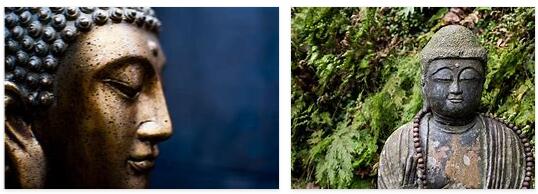
In Cambodia, In Mongolia and the traditionally Buddhist areas within the Russian Federation (Russia), Buddhism experienced a rebirth after the collapse of the communist state order (1990/91) and has regained its traditional religious and social position. Buddhism has also experienced a »renaissance« in China since the 1980s. However, while the development of the Buddhist communities in north-west and north-east China (Sinkiang, Inner Mongolia, Heilongjiang) largely benefited from the liberalization of state religious policy practiced since 1978/79, Buddhism is in Tibet (as the factor integrating the national and cultural [self-] consciousness of the Tibetans) is still exposed to state influence and repression, which repeatedly provokes resistance from Buddhist Tibetans (most recently in 2008: demonstrations by monks turn into unrest).
Teach
All earthly, subterranean and supernatural beings are equally subject to the law of the causal retribution of all good and bad deeds (karma ), so that in the cosmos there is constant birth and death, in which the individual beings constantly change their modes of existence. The worlds with the exception of the upper heavens are in a constant alternation of growth and decay; if a world has come to an end, only an empty space remains in its place. A new world emerges from him as a result of the karma of the residents of the earlier world. This process continues until all karma is eliminated, i.e. H. all beings who have attained perfect knowledge and freedom from all desires.
In contrast to other religions, Buddhism teaches that there are no eternal, imperishable substances: neither matter nor a permanent soul or personality, neither a personal master of the world nor an impersonal absolute, which forms the basis of the world. Rather, every individual and the world they experience comes only through factors of existence (Sanskrit: Dharma, Pali: Dhamma), which are functionally dependent on each other and lawfully arise and then disappear again. The dharmas are no longer reducible, objectively imagined forces which, through their interaction, produce the individual beings and the world they perceive. When an individual dies, the connection between the dharmas that formed them is broken; the samskaras (driving forces) of morally good or bad meaning, d. H. the impulses of will that have become karma become the basis of a new being who receives reward or punishment for the good or bad works of the deceased. So Buddhism does not teach » transmigration of souls «, But the growth of a new being out of the karma of what has passed away. This is illustrated in detail by the famous doctrine of “arising in dependence” (Sanskrit: Pratityasamutpada, Pali: Paticcasamuppada), the twelve members of which, according to the general Buddhist tradition, represent the causally determined becoming of a personality in successive existences; The ultimate cause of suffering and entanglement in the cycle of birth appears to be ignorance (Avidya ).
According to foodezine.com, the wheel (chakra) is the symbol of the various forms of existence that require redemption. According to the teachings of Buddhism, being born again and having to die again has been going on for as long as man does not recognize that everything is “transitory, without persistent substance and therefore painful”. Suffering (Sanskrit: Duhkha, Pali: Dukkha) in Buddhism is the calamity that lies in the fact of individual existence. It becomes evident in physical and mental pain. The first of the “four noble truths” speaks of this painful experience: The existence factors of the individual living being (“everything real is individual”) are then generally full of suffering and calamity. According to the “second noble truth”, the causes of suffering are “thirst” (Sanskrit: Trishna, Pali: Tanha), desire, the will to live. They are overcome, as the “third noble truth” says, in the “quenching of thirst”, the mortification of desire and all passions (above all greed, hatred and delusion). The “fourth noble truth” finally shows the “noble eightfold path” which leads to the abolition of the cause of suffering: right view and disposition, right speech, Action and life, right striving, thinking and immersion. Several of these terms are synonymous, the path to salvation can therefore be traced back to three levels: morality (virtuous behavior in thoughts, words, deeds), immersion and redeeming knowledge. This is not the result of rational thinking, but of profound insight; it again has three members, is “threefold knowledge”: memory of one’s own previous existences, knowledge of the law of karma, knowledge of the “four noble truths”. This closes the circle, for the fourth of these truths shows the way that leads to the cessation of suffering; the monk has already walked it on the basis of instruction. The reception of the teaching now expands into intuitive vision. So »… (the) spirit is freed from the delusion of desire, of being worldly, of ignorance; to the redeemed the knowledge becomes: the redemption is accomplished, the birth uproots, the holy walk completed,… there is no further birth ”(Dighanikaya 2, 98). In the present existence, which continues until death, that is already the case Nirvana, the “blowing away”, “extinction” is achieved, which after death is followed by “perfect nirvana” (Sanskrit: Parinirvana, Pali: Parinibbana). Only nirvana is eternal and independent in Buddhism. In addition to humans, animals, hungry spirits and demons, the gods also need redemption and, like them, are subject to the cycle of births.